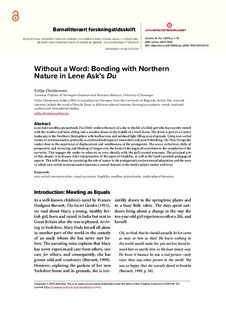Without a Word: Bonding with Northern Nature in Lene Ask’s "Du"
Journal article, Peer reviewed
Published version
Permanent lenke
http://hdl.handle.net/11250/2635389Utgivelsesdato
2019Metadata
Vis full innførselSamlinger
Originalversjon
Christensen, S. (2019) Without a Word: Bonding with Northern Nature in Lene Ask’s "Du". Barnelitterært forskningstidsskrift, 10(1) https://doi.org/10.18261/issn.2000-7493-2019-01-10Sammendrag
Lene Ask’s wordless picturebook Du (2016) renders the story of a day in the life of a little girl who has recently moved with her mother and baby sibling into a wooden house in the middle of a birch forest. The forest is part of a wintery landscape in the Northern Hemisphere with leafless trees and subdued light filling several spreads. Using non-verbal means of communication, primarily a combined technique of watercolors and pencil sketching, Du (You) brings the reader close to the experience of displacement and wordlessness of the protagonist. The scarce verbal text, shifts of perspective, and mirroring and bleeding of images over the limits of the pages all contribute to the complexity of the narrative. This engages the reader to relate to, or even identify with, the girl’s mental processes. The principal aim of this chapter is to discuss Ask’s interpretation of the topos of biophilia, as well as the book’s possible pedagogical aspects. This will be done by examining the role of nature in the protagonist’s environmental adaptation and the ways in which non-verbal communication becomes a central element in the book’s subject matter and form. Keywords: non-verbal communication, visual narratives, biophilia, wordless picturebooks, multicultural literature

